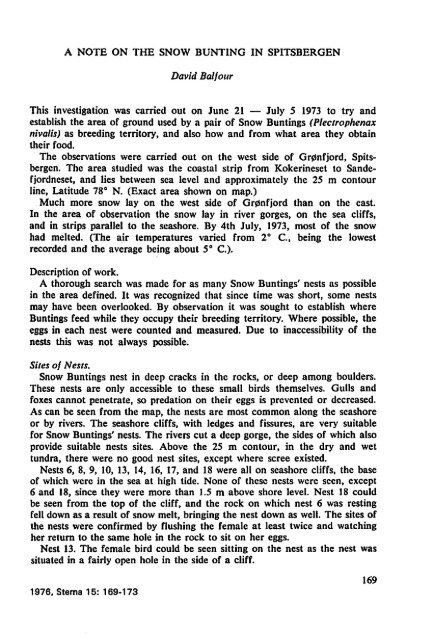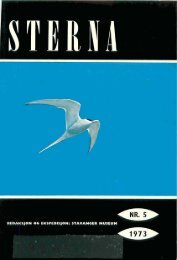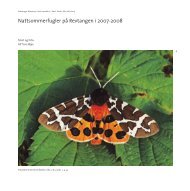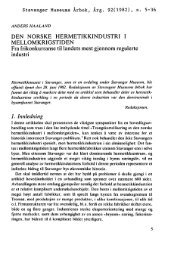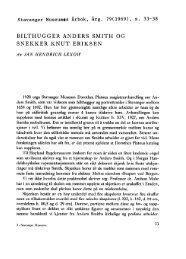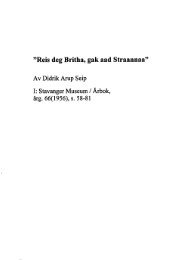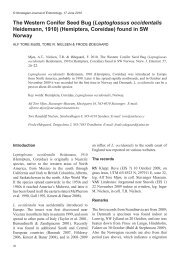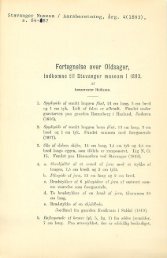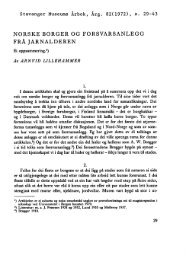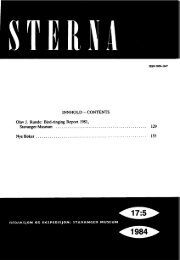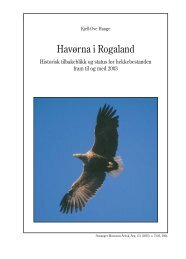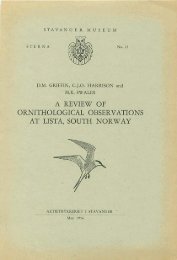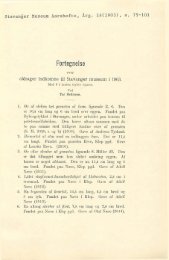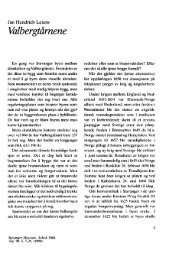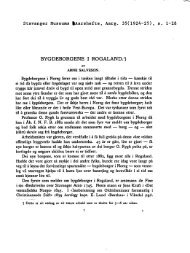Sterna, bind 15 nr 3 (PDF-fil) - Museum Stavanger
Sterna, bind 15 nr 3 (PDF-fil) - Museum Stavanger
Sterna, bind 15 nr 3 (PDF-fil) - Museum Stavanger
You also want an ePaper? Increase the reach of your titles
YUMPU automatically turns print PDFs into web optimized ePapers that Google loves.
A NOTE ON THE SNOW BUNTING IN SPITSBERGEN<br />
David Balfour<br />
This investigation was carried out on June 21 - July 5 1973 to try and<br />
establish the area of ground used by a pair of Snow Buntings (Plectrophenax<br />
nivalis) as breeding territory, and also how and from what area they obtain<br />
their food.<br />
The observations were carried out on the west side of Grgnfjord, Spitsbergen.<br />
The area studied was the coastal strip from Kokerineset to Sandefjordneset,<br />
and lies between sea leve1 and approximately the 25 m contour<br />
line, Latitude 78" N. (Exact area shown on map.)<br />
Much more snow lay on the west side of GrØnfjord than on the east.<br />
In the area of observation the snow lay in river gorges, on the sea cliffs,<br />
and in strips parallel to the seashore. By 4th July, 1973, most of the snow<br />
had melted. (The air temperatures varied from 2" C., being the lowest<br />
recorded and the average being about 5" C.).<br />
Description of work.<br />
A thorough search was made for as many Snow Buntings' nests as possible<br />
in the area defined. It was recognized that since time was short, some nests<br />
may have been overlooked. By observation it was sought to establish where<br />
Buntings feed while they occupy their breeding territory. Where possible, the<br />
eggs in each nest were counted and measured. Due to inaccessibility of the<br />
nests this was not always possible.<br />
Sites of Nests.<br />
Snow Buntings nest in deep cracks in the rocks, or deep among boulders.<br />
These nests are only accessible to these small birds themselves. Gulls and<br />
foxes cannot penetrate, so predation on their eggs is prevented or decreased.<br />
As can be seen from the map, the nests are most common along the seashore<br />
or by riven. The seashore cliffs, with ledges and fissures, are very suitable<br />
for Snow Buntings' nests. The rivers cut a deep gorge, the sides of which also<br />
provide suitable nests sites. Above the 25 m contour, in the dry and wet<br />
tundra, there were no good nest sites, except where scree existed.<br />
Nests 6, 8, 9, 10, 13, 14, 16, 17, and 18 were all on seashore cliffs, the base<br />
of which were in the sea at high tide. None of these nests were secn, except<br />
6 and 18, since they were more than 1.5 m above shore level. Nest 18 could<br />
be seen from the top of the cliff, and the rock on which nest 6 was resting<br />
fell down as a result of snow melt, bringing the nest down as well. The sites of<br />
the nests were confirmed by flushing the female at least twice and watching<br />
her return to the same hole in the rock to sit on her eggs.<br />
Nest 13. The female bird could be seen sitting on the nest as the nest was<br />
situated in a fairly open hole in the side of a cliff.<br />
1976, <strong>Sterna</strong> <strong>15</strong>: 169-1 73<br />
169


